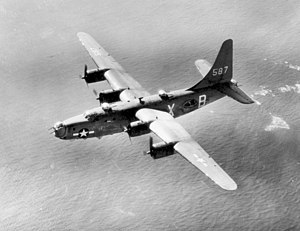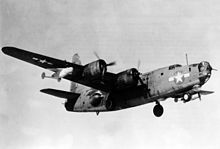Consolidated PB4Y
| Consolidated PB4Y | |
|---|---|
 US Navy Consolidated PB4Y-2 |
|
| Type: | Maritime patrol aircraft |
| Design country: | |
| Manufacturer: | |
| First flight: |
PB4Y-1 (B-24D): 1942 |
| Commissioning: |
1942/1944 |
| Production time: |
1942 to 1945 |
| Number of pieces: |
PB4Y-1: 977 |
The Consolidated PB4Y Privateer was a four-engine maritime patrol aircraft and patrol bomber produced by the US manufacturer Consolidated Aircraft (from 1943 Consolidated Vultee Aircraft Corporation ), which was used in World War II and at the beginning of the Cold War .
PB4Y-1 Liberator
In 1942 the United States Navy had recognized that seaplanes only partially met the requirements for maritime patrols. The search was therefore for a long-range bomber in production that was suitable for this task. Both the Royal Air Force and the United States Army Air Forces already used the Consolidated B-24 Liberator in this role. On July 7, 1942, the US Navy and USAAF signed an agreement that guaranteed the Navy a share of the B-24 shipments. Just a month later, the first B-24D were handed over to the US Navy. In August 1943, the USAAF finally dissolved its "Anti-Submarine Command" (anti-submarine command) and handed over all B-24s deployed there to the USN. Overall, the Navy received 977 Liberator series B-24D / G / J / M, all of which were designated as PB4Y-1 Liberator .
In addition to monitoring the sea area, the PB4Y-1 was also used for special missions as a flying bomb in Europe. For this purpose, two machines were equipped with a television camera in the nose and a remote control and loaded with around 11,000 kg of explosives. Two pilots had to start a machine manually and then later jump off with a parachute before the aircraft was steered into the target by a guided aircraft of the type PV-1 Ventura . The first use was to take place on August 12, 1944 against German V-2 rocket positions in France ("Anvil" project). However, the machine exploded 20 minutes after take-off, killing the two pilots (Lt. Joseph P. Kennedy, Jr. , brother of John F. Kennedy , and Lt. Wilford J. Willy). The deployment of the second PB4Y-1, however, was successful when the airfield on Heligoland was attacked on September 3, 1944 .
Up until 1952, reconstructed PB4Y-1P were used as reconnaissance squadrons VJ-61 and VJ-62.
PB4Y-2 Privateer
Despite the success of the PB4Y-1 in the Atlantic battle and the Pacific war , the US Navy wanted a version of the B-24 that was more tailored to their needs. The fuselage was extended by 1.57 m and the aircraft received a new tail unit. To improve the flight performance of the B-24, the Ford Motor Company , which built the Liberator under license, fitted a B-24D with the tail of a Douglas B-23 . This "XB-24K" had better flight characteristics than the B-24D, but for reasons of cost and time, the construction was not taken over into series production. A later series production of an improved B-24N was not carried out in Europe at the end of the war. The US Navy, however, took over the construction as PB4Y-2 Privateer .
The PB4Y-2 had a different armament. The spherical combat stand on the underside of the fuselage was omitted, instead there were two rotating towers on the upper side of the fuselage and two side stands. There was also a turret in the bow and in the stern, so that a total of twelve 12.7 mm machine guns were available. In the front part of the fuselage there was space for various radar antennas for surveillance of the sea area. The drive was 14-cylinder double radial engines Pratt & Whitney R-1830-94 Twin Wasp, which however no longer had a turbocharger, since the aircraft mostly operated at low altitude.
The prototype first flew on September 20, 1943. A total of 736 “Privateers” were built. From 1951 the US Navy designated the Privateer as P4Y-2 , from 1962 as P-4 . The PB4Y-2 was the first US Navy aircraft to use radar-guided ASM-N-2 Bat glide bombs. The only operation took place on April 23, 1945 against Japanese ships in the port of Balikpapan on Borneo .
The patrol squadrons of the US Navy flew the P4Y-2 until 1954. It was a machine of the squadron VP-26 after its start in Wiesbaden on April 9, 1950 by Soviet Lavochkin-La-11 fighter aircraft over the Baltic Sea near the Latvian coast at Liepāja shot down. The ten crew members have been missing since then. On September 20 and November 23, 1952, two more P4Y-2s were attacked off the coast of China, but were able to return to their bases. The last privateers flown by the US Navy were P4Y-2K target aircraft, which flew until the early 1960s.
The United States Coast Guard received four PB4Y-1Gs in 1944 and eleven PB4Y-2Gs in 1946, the latter in service until 1958.
In 1950 France received 22 PB4Y-2S, which were used by the naval squadrons ("flotilla") 6F, 8F and 28F from Tan Son Nhut in the Indochina War. By 1954, four machines were lost and six were returned to the United States. The rest were used in the Algerian War and during the Suez Crisis in 1956, until they were replaced by the Lockheed P-2 in 1961 .
Taiwan received 38 P4Y-2s from 1952 to 1956, which were in service until 1961. One was shot down during an operation over Burma in 1961 .
Finally, Honduras used three P4Y-2s converted as transporters until the early 1970s, and some civilian privateers are still in use as fire-fighting aircraft today .
variants
- PB4Y-1
- Designation for 977 delivered to the US Navy B-24D / G / J / M.
- PB4Y-1G
- four PB4Y-1s delivered to the US Coast Guard in 1944.
- PB4Y-1P
- PB4Y-1 converted into reconnaissance aircraft.
- XPB4Y-2
- three B-24, which were equipped with an elongated fuselage, a single vertical tail and R-1830-94 engines.
- PB4Y-2
- Series version of the XPB4Y-2, 736 built (from 1951 on all PB4Y were designated as P4Y).
- PB4Y-2B
- PB4Y-2, which could be equipped with radar-guided ASM-N-2- Bat glide bombs.
- PB4Y-2G
- eleven PB4Y-2s converted as unarmed sea rescue aircraft.
- PB4Y-2K
- PB4Y-2 converted as unmanned target display aircraft (from 1951 P4Y-2K, from 1962 QP-4B).
- PB4Y-2M
- PB4Y-2 converted as a weather reconnaissance aircraft.
- PB4Y-2S
- PB4Y-2 with special radar for submarine hunting.
- RY-1
- three C-87A (transport version of the B-24) of the US Navy.
- RY-2
- five US Navy C-87s.
- RY-3
- Transport variant of the PB4Y-2, 39 built.
Technical specifications
| Parameter | PB4Y-1 | PB4Y-2 |
|---|---|---|
| length | 21.16 m | 22.73 m |
| span | 33.53 m | 33.53 m |
| height | 5.49 m | 9.17 m |
| Wing area | 97.40 m² | 97.36 m² |
| Takeoff weight (maximum) | 29,500 kg | 29,500 kg |
| Empty weight | 17,250 kg | 17,000 kg |
| Top speed | 480 km / h at 9,150 m altitude | 380 km / h |
| Max. Range | 3,360 km | 4,500 km |
| Service ceiling | 8,550 m | 6,300 m |
| drive | four Pratt & Whitney R-1830-65 Twin Wasp double radial engines with 1,200 hp each |
four Pratt & Whitney R-1830-94 double radial engines with 1,350 hp each |
| Armament | ten 12.7 mm machine guns and up to 3,800 kg bombs | twelve 12.7 mm machine guns and up to 5,800 kg bombs |
literature
- Peter M. Bowers : United States Navy Aircraft since 1911. Naval Institute Press, Annapolis (Maryland, USA) 1990, ISBN 0-87021-792-5 , pp. 103-106.
Web links
Individual evidence
- ↑ DPMO Cold War Incidents Report: Incident Data 2000-08-31 ( Memento of February 14, 2010 in the Internet Archive )
- ↑ PB4Y-1 with the US Coast Guard
- ↑ P4Y-2 with the US Coast Guard
- ↑ PB4Y on www.joebaugher.com






